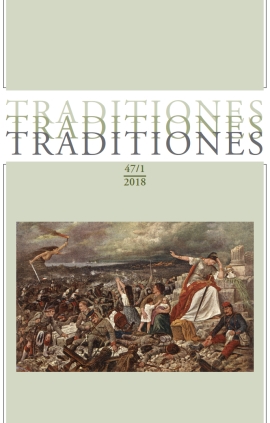“Karte” prve svetovne vojne: zemljevidenje poljske krajine pozabe v Legnici
DOI:
https://doi.org/10.3986/Traditio2018470107Ključne besede:
boundaries, cultural landscape, memory studies, metaphor, Legnica, The First World War // meje, kulturna krajina, spominske študije, metafora, prva svetovna vojnaPovzetek
This article focuses on mapping the landscape of forgetting in the context of World War I in Legnica (Liegnitz), a town in southwestern Poland. It describes the process of (re)constructing and (re) negotiating the cultural landscape of the town by using the metaphors of conversation and conflict. This analysis shows that World War I remains a past that is impossible to deal with by Legnica’s contemporary inhabitants.
***
Osrednji fokus članka je zemljevidenje krajine pozabe v kontekstu prve svetovne vojne v Legnici (Liegnitz), mestu na poljskem jugozahodu. Avtorica opisuje proces (ponovne) gradnje in (ponovnega) pogajanja o kulturni krajini mesta z rabo metafor pogovora in konflikta. Njena analiza priča o tem, da ostaja prva svetovna vojna preteklost, ki je prebivalci Legnice ne zmorejo rešiti.
Prenosi
Literatura
Andrzejewski, Andrzej. 2016. Akademia Rycerska w Legnicy odzyskała dawny blask. Available at http://www.radi- owroclaw.pl/articles/view/51685/Akademia-Rycerska-w-Legnicy-odzyskala-dawny-blask-REPORTAZ
Assmann, Aleida. 2008. Canon and Archive. In: Astrid Erll and Ansgar Nünning (eds.), Cultural Memory Studies. An International and Interdisciplinary Handbook. Berlin and New York: Walter de Gruyter, 97–107.
Bender, Barbara. 2001. Introduction. In: Barbara Bender and Margot Winer (eds.), Contested Landscapes: Movement, Exile and Place. Oxford and New York: BERG, 1–18.
Benediktsson, Karl and Katrín A. Lund. 2010. Introduction: Starting a Conversation with Landscape. In: Karl Benediktsson and Katrín Anna Lund (eds.), Conversations with Landscape. Ashgate e-Book, 1–12.
Central Statistical Office. 2007. Area and Population in the Territorial Profile in 2007. Warszawa: Zakład Wydawnictw Statystycznych. Available at www.stat.gov.pl
Cornwall, Mark. 2016. A Conflicted and Divided Habsburg Memory. In: Mark Cornwall and John Newman (eds.), Sacrifice and Rebirth. The Legacy of the Last Habsburg War. New York and Oxford: Berghahn, 1–12.
Daniels, Stephen and Denis Cosgrove. 1988. Introduction: iconography and landscape. In: Denis Cosgrove and Stephen Daniels (eds.), The Iconography of Landscape. Cambridge: Cambridge University Press, 1–10.
Dąbrowski, Stanisław (ed.). 1998. Zarys monografii miasta. Wrocław and Legnica: DTSK Silesia.
Demski, Dagnosław. 2003. Pogranicze jako patchwork. Refleksje z Białorusi. Etnografia Polska 47(1–2): 129–148.
Deutsche, Rosalyn. 1996. Evictions: art and spatial politics. Cambridge: MIT Press.
Exhibition 2014. The Image of the World War I in the State Archive in Wrocław, Division in Legnica. Available at http://www.ap.wroc.pl/sites/default/files/obraz-pierwszej-wojny-swiatowej/index.html#(1).
Hirsch, Eric. 1995. Introduction. Landscape: Between Place and Space. In: Eric Hirsch and Michael O’Hanlon (eds.), The Anthropology of Landscape. Perspectives on Place and Space. Oxford: Clarendon Press, 1–31.
Humeńczuk, Grażyna. 2000. Legnickie pomniki przed II wojną światową. Legnica: Muzeum Miedzi.
Kobyliński, Zbigniew. 2014. Krajobraz jako pamięć. In: Jacek Wysocki (ed.), Archeologica Hereditas. Konserwacja zapobiegawcza środowiska. Krajobraz kulturowy 2. Warszawa and Zielona Góra: Instytut Archeologii Uniwersytetu Kardynała Wyszyńskiego, 13–22.
Makuch, Marcin. 2015. Sekrety Legnicy. Łódź: Książy Młyn Dom Wydawniczy.
Levy, Daniel and Natan Sznaider. 2006. The Holocaust and the Memory in the Global Age. Philadelphia: Temple University Press.
Saunders, Nicholas J. 2001. Matter and Memory in the Landscapes of Conflict: The Western Front 1914–1999. In: Barbara Bender and Margot Winer (eds.), Contested Landscapes: Movement, Exile and Place. Berg: Oxford and New York, 37–53.
Sowa, Andrzej L. 2011. Historia polityczna Polski 1944–1991. Kraków: Wydawnictwo Literackie.
Tilley, Christopher. 1994. A Phenomenology of Landscape: Places, Paths and Monuments. Oxford: Berg.
Ucko, Peter J. and Robert Layton. 1999. Introduction: gazing on the landscape and encountering the enviro- nment. In: Peter J. Ucko and Robert Layton (eds.), The Archaeology and Anthropology of Landscape: Shaping your Landscape. London: Routledge, 1–20.
Vedder, Ben. 2002. On the Meaning of Metaphor in Gadamer’s Hermeneutics. Research in Phenomenology 32: 196–209.
Vukov, Nikolai. 2015. Memory and Monumental Representation of the Great War: the Balkan Projections. In: Ana Luleva, Ivanka Petrova and Slavia Barlieva (eds.), Contested Heritage and Identities in Post- Socialist Bulgaria. Sofia: Gutenberg Publishing House, 32–59.
Waage, Edda R. H. 2010. Landscape as Conversation. In: Karl Benediktsson and Katrín A. Lund (eds.), Conversations with Landscape. Ashgate e-Book, 45–58.
Winter, Jay. 2008. Sites of Memory and the Shadow of War. In: Astrid Erll and Ansgar Nünning (eds.), Cultural Memory Studies. An International and Interdisciplinary Handbook. Berlin and New York: Walter de Gruyter, 61–74.
Zaremba, Łukasz. 2016. Od tłumacza. In: Nicholas Mirzoeff, Jak zobaczyć świat (How to See the World). Kraków and Warszawa: Karakter, 5–15.
Prenosi
Objavljeno
Kako citirati
Številka
Rubrike
Licenca
Avtorji jamčijo, da je delo njihova avtorska stvaritev, da v njem niso kršene avtorske pravice tretjih oseb ali kake druge pravice. V primeru zahtevkov tretjih oseb se avtorji zavezujejo, da bodo varovali interese založnika ter da bodo povrnili morebitno škodo.
Podrobneje v rubriki: Prispevki






